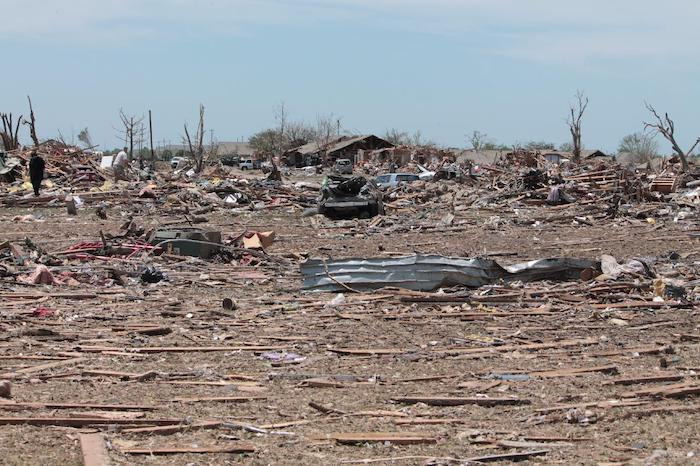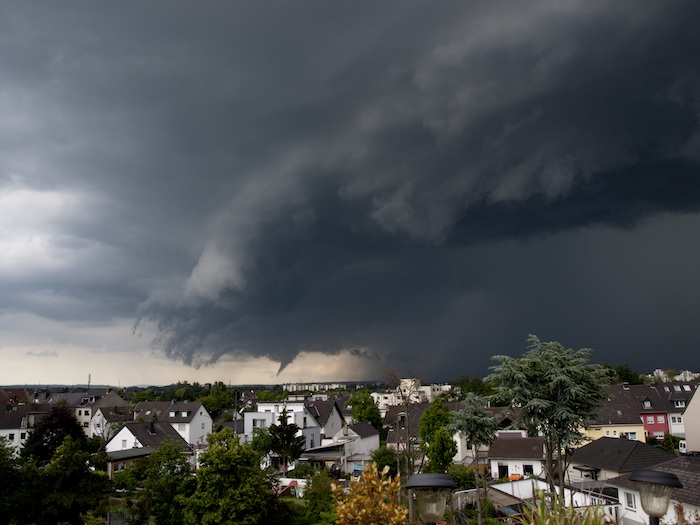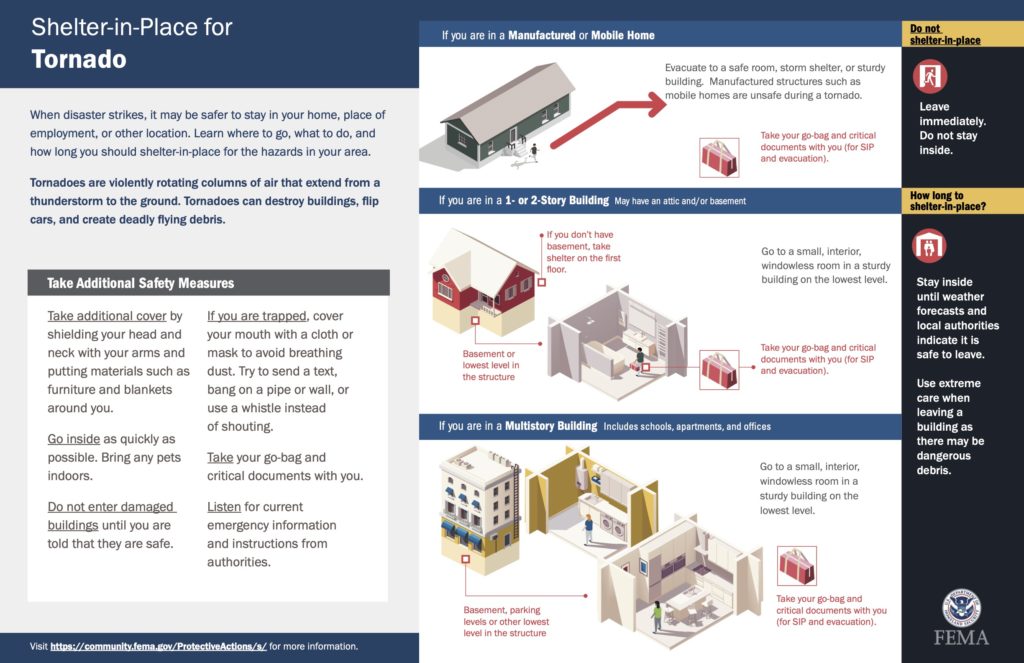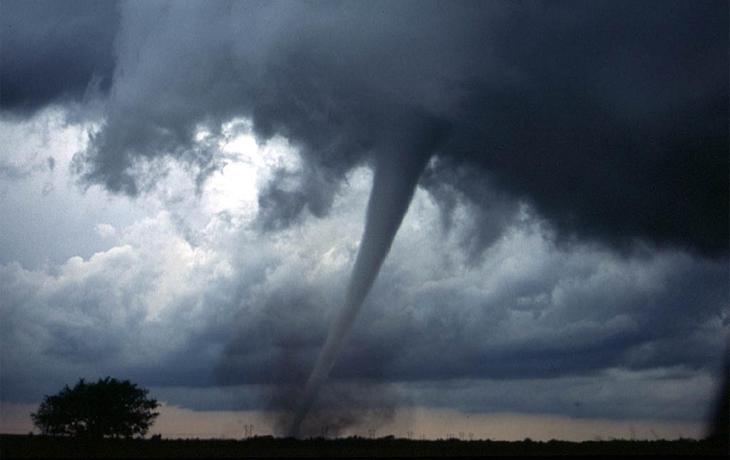Tornadoes can happen anywhere in the world. They’ve been spotted in Argentina, Great Britain, India, and other countries — but they’re most common in the United States. The United Kingdom has the most tornadoes per land size, with 33 each year, but the United States has over 1,000 each year!
Risky areas in the US are Florida and a region known as Tornado Alley that stretches from Northern Texas up to South Dakota. Tornado Alley is vaguely defined, and sometimes includes other northern states like Minnesota and Wisconsin. Another area prone to tornadoes is called Dixie Alley that encompasses the Southeastern United States, which stretches from Eastern Texas to the Carolinas.
Do you know what to do in a tornado?
The most important info:
- Tornadoes happen when hot and cold air collide, so spring and fall are common seasons, although they can happen throughout summer, too.
- If you see a tornado or are put on alert by your local weather service, your best chance of survival is inside a sturdy shelter that’s either underground or at the core of a building (no windows or exterior walls).
- Warning signs of a tornado: pitch black sky, roaring sound, debris falling from the sky, debris swirling in the air, sudden eerie quiet.
- Mobile homes are not appropriate shelters from a tornado. Seek the sturdiest structure you can find.
- Do not hide under highway overpasses — that narrow passage can actually increase the wind speed (like putting your finger on the end of a running water hose).
- Bring your go-bag and other gear into your shelter if possible.
- Most injuries happen during the aftermath. Move carefully and help who you can.

Why you can trust us
Author Josh Centers has lived in Dixie Alley his entire life, where tornadoes are a common occurrence. He’s lived through more tornado watches and warnings than he can count. He currently lives in Macon County, TN where the 2008 EF-3 Super Tuesday Tornado destroyed much of the western half of the county, killing 14 people, causing an explosion at a natural gas transfer station, and warranting a visit from then-president George W. Bush.
How tornadoes form
Tornadoes are formed from large thunderstorms called supercells or rotating thunderstorms. A supercell contains a rotating updraft called a mesocycle. The mesocycle draws in warm air from the thunderstorm, causing it to build speed. When the warm air mixes with cool air, the mesocycle builds energy, and moisture in the air forms a funnel cloud as the air spins.
When the mesocyclone grows large enough, it descends from the cloud, touches the ground, and becomes a tornado, which can last anywhere from seconds to hours.
Enhanced Fujita scale ratings
You might be familiar with the original Fujita scale, with designations like F3 or F5, named for meteorologist Ted Fujita. That scale has been updated to the Enhanced version in 2007:
- EFU: Unknown wind speed, no surveyable damage
- EF0: 65-85 mph, light damage
- EF1: 86-110 mph, moderate damage
- EF2: 111-135 mph, considerable damage
- EF3: 136-165 mph, severe damage
- EF4: 166-200 mph, devastating damage
- EF5: Over 200 miles per hour, incredible damage
There have been 59 EF5 tornadoes in the United States since 1953, with the most recent being one in Moore, Oklahoma in 2013, which killed 24 people and caused $2 billion in damage.
Tornado warning signs
If you live in the Midwestern or Southeastern United States, you should be prepared for tornadoes in the spring and fall, in which high-pressure and low-pressure systems are most likely to meet. Your first line of defense is emergency alerts on your smartphone or from a weather radio. Then tune into local media like TV, radio, or live streams to follow the situation.
The National Weather Service gives two types of tornado alerts: tornado watch and tornado warning.
- Tornado watch means that a tornado is possible in your area. Make your last minute preparations, get your safe room ready, and be on alert.
- Tornado warning means that a tornado has been sighted in your area. Take shelter immediately.
If you live in a tornado-prone area, there may be wind-activated alert sirens you can listen for. Macon County, TN had those during the 2008 tornado, but it didn’t work and many residents were caught flatfooted. The county now tests the system on the first Saturday of the month.
The signature of a tornado is the classic funnel cloud. However, in reality, you may never see one.

Other signs to look for:
- The sky suddenly turning pitch black
- A loud roaring or whistling sound
- Sudden, eerie quiet
- Clouds of debris or debris dropping from the sky
You might also see miniature cyclones on the ground that stir up dirt, leaves, and other debris.
The black sky is a key indicator, which is why tornadoes are especially deadly at night because it’s hard to tell if the sky has darkened due to a tornado or if it’s just night. It’s also easy to sleep through alerts and the roaring noise. iOS and Android both can alert you to inclement weather, but it’s not always reliable, so it’s good to also have a weather radio with an alert function you can turn on when the weather looks nasty.
A safe room is your best option
Not only is a safe room where you should move to during the ‘nado, but it’s the best way you can prepare ahead of time, whether that’s building a storm shelter or simply picking and stocking the right existing room in your house. You don’t want to be thinking through these things for the first time when the storm is nearby.
If a tornado warning has been issued, don’t stare out the window or go outside to look for signs. Get to your shelter immediately. Bring your pets with you, if possible.
We’ll cover gear that can be helpful during and after a tornado, but your chief prep for tornadoes is a durable shelter to hunker down in. Tornadoes are one of the most powerful forces of nature and there’s nothing that can be done about them, so your best bet is sheltering and riding it out.

The absolute best place to shelter is an underground storm cellar. Unfortunately, most of us don’t have one of those, so here are some guidelines for picking a room:
- Inside a sturdy building like a house or apartment building. If you have a choice of building, pick the sturdiest one!
- On the lowest level possible. A basement is ideal.
- Absolutely NO windows! Tornadoes easily shatter windows and send glass flying.
- An interior room with no outside walls.
Bathrooms and closets are often good choices if you don’t have a storm shelter or basement.
Unfortunately, if you live in a mobile home (a trailer, RV, or camper), it is not a suitable shelter. There’s a stereotype about trailer parks and tornadoes for a reason. If that’s your living situation, scout out a suitable shelter well in advance of tornado season, such as a brick-and-mortar communal laundry building nearby.
If you have time, it pays to prep the room, especially if it’s small. Clean out any junk so you have plenty of room. Also, clear off shelves and anything that might fall on your head.
The best position, if you can manage it, is to get on your knees, put your face to the ground, and cover your head with your hands. FEMA recommends also covering your head with blankets and furniture if available.
If this shelter room isn’t where you normally store your primary bug out bag anyway, grab the bag on your way in, so you’ve got your kit with you in case you’re trapped in that room for a while.
What if you’re caught in a tornado without strong shelter?
What can you do to shelter from a tornado if you live in a mobile home, are stuck in a vehicle, or out in the field? Your two best options are to shelter in a vehicle or a ditch.
FEMA research indicates:
- A vehicle may be safer than a mobile home during a tornado. Wind speed of 87 miles per hour can slide a 2,400-pound car, while unanchored cottages and mobile homes slide off their foundations at 72 miles per hour.
- “Risk of death, severe injury, or minor injury was not greater among persons in motor vehicles than among those in houses,” according to a study published in the American Journal of Epidemiology.
- “Most vehicles parked outside houses with damage as high as F3 were not moved by the wind and were not tipped by the wind,” according to a study published in the Journal of Safety Research.
Follow these guidelines when a tornado warning has been issued and you don’t have access to a sturdy building:
- Avoid being under a freeway, overpass, or any trees, which could fall on you. (It’s a survival myth that you should hide under an overpass during a tornado.)
- The heavier the vehicle, the better. You’re better off in a GMC Yukon than a Mazda Miata.
- Newer vehicles are better than older vehicles because of greater safety features, like safety glass.
- Put on your seatbelt.
- Don’t attempt to outrun the tornado.
- If sheltering in a vehicle is not an option, get into a ditch or low area away from trees or other things that can fall on your head.
- Cover your head and neck with your arms and any available cover, like blankets and coats.
Helpful gear during a tornado
If you live in a tornado-prone area, you might modify your bug out bag and/or store spare gear in your shelter because it’s specifically helpful before and during a tornado:
- Boots: Help you deal with all the broken glass, wood, etc. spread on the ground.
- Fire extinguisher: Since you’re going to have a fire extinguisher around anyway, may as well put it on in the shelter area of your home. Fires are common after tornados.
- Goggles: To protect your eyes from flying debris.
- Dust mask, respirator, or other face covering: To keep from breathing in any dust in the aftermath.
- Hard hat: Perhaps a bit extreme, but it offers extra protection for your head.
- Flashlight, headlamp, or lantern: Power outages are common after tornadoes, and if you’re buried under rubble, you might not be able to see.
- Weather radio: To monitor for additional warnings or an all-clear message.
- VHF/UHF ham radio: If you’re a licensed ham radio operator, you can help your community in a crisis by reporting and relaying information with other local hams.
- Individual first aid kit: To treat any immediate injuries.
Dealing with the aftermath
Don’t assume the sky is clear just because it’s quiet or the sun comes out. You may be in a storm eye with the worst yet to come. Monitor alerts from NOAA or local broadcast stations to ensure that the storm has passed.
Keep in mind that most tornado-related injuries occur in the aftermath: during rescue, cleanup, and the struggles of days, weeks, or months of broken infrastructure.
Things to do:
- Be on the lookout for loose boards, nails, exposed wiring, broken pipes, gas leaks, shattered windows, and roof damage. Move carefully.
- Check on your family and pets, help those closest to you that may be trapped, and treat whatever injuries that you can.
- Be prepared to cut power at the main break, turn off water either inside your house or at the meter (with a water cutoff key), and turn off gas lines (if possible).
- Based on what you see, make the decision whether you can stay in your home or whether you have to leave.
- If you smell gas, leave immediately after shutting off whatever gas lines you can and main power. Contact EMS as soon as possible.
- Hang up or disconnect any landline phone receivers to keep the lines clear.
If a gas leak is possible, avoid turning on lights, lighting matches, or smoking until you’ve secured the area.
Once you’ve secured the inside of your home or made the decision to leave, carefully venture outside and survey the area. Be on the lookout for:
- Fallen trees and branches
- Structural damage to your home or property
- Downed power lines
- Gas leaks
- Fires
Again, make a decision on whether to bug in or bug out. If you can, contact EMS or local utilities in the case of downed power lines or broken gas lines.
If you’ve decided to stay home and things are otherwise fine, start considering your broader community. Check on your neighbors. If you’re a ham radio operator, listen in and sign onto local repeaters to offer status reports and help coordinate with emergency responders.
Once the (figurative or literal) smoke clears, contact your insurance company to start the claims process. Most homeowners’ or renters’ insurance policies cover tornado damage. It helps to have photos of your home and property, as well as an inventory of your valuables in a safe place, like in cloud storage.
Useful gear for the aftermath
As with any emergency scenario, your basic core preps are the foundation. Having a few weeks’ worth of food and water stored, for example, will help you get through the aftermath when everything is chaotic and broken.
Beyond the universal basics, these items can be specifically helpful after the tornado is over:
- Water meter key and/or wrenches: You may need to turn off your water or gas lines from the meter.
- The power could be out, so you’ll rely on generators, power packs, batteries, headlamps, and lanterns
- Sturdy work gloves will help while dealing with debris.
- Tools that help clear debris, such as axes, hatchets, chainsaws, pry bars, sledgehammers, Sawzalls / cordless reciprocating saws, and so on. Don’t forget stored fuel.
- Winch and tow straps: If you have a truck or other work vehicle, you can use these to move tree trunks and large branches.
- Plastic sheets or large trash bags and duct or gaffer tape: In case you need to seal openings left by broken windows.
- Large tarps: Can be those very large but cheap tarps you get at local big box stores since this is more about covering large holes/sections missing from your house for the weeks afterward.
